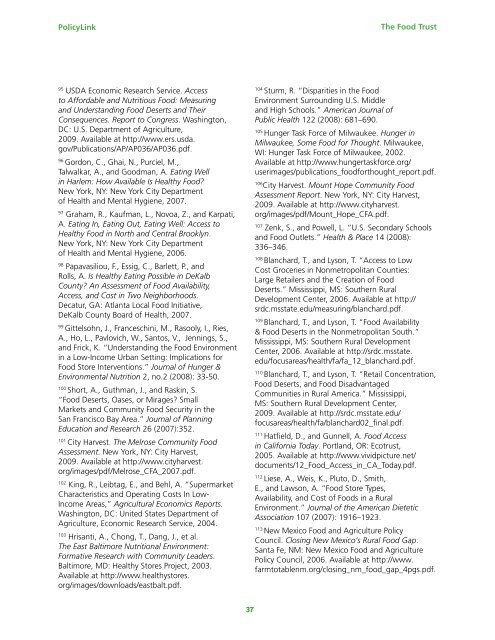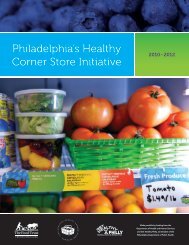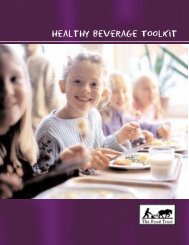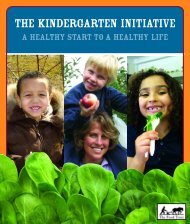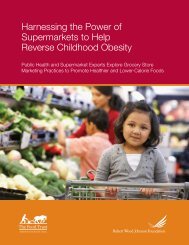The Grocery Gap: Who Has Access to Healthy - The Food Trust
The Grocery Gap: Who Has Access to Healthy - The Food Trust
The Grocery Gap: Who Has Access to Healthy - The Food Trust
You also want an ePaper? Increase the reach of your titles
YUMPU automatically turns print PDFs into web optimized ePapers that Google loves.
PolicyLink<strong>The</strong> <strong>Food</strong> <strong>Trust</strong>95USDA Economic Research Service. <strong>Access</strong><strong>to</strong> Affordable and Nutritious <strong>Food</strong>: Measuringand Understanding <strong>Food</strong> Deserts and <strong>The</strong>irConsequences. Report <strong>to</strong> Congress. Washing<strong>to</strong>n,DC: U.S. Department of Agriculture,2009. Available at http://www.ers.usda.gov/Publications/AP/AP036/AP036.pdf.96Gordon, C., Ghai, N., Purciel, M.,Talwalkar, A., and Goodman, A. Eating Wellin Harlem: How Available Is <strong>Healthy</strong> <strong>Food</strong>?New York, NY: New York City Departmen<strong>to</strong>f Health and Mental Hygiene, 2007.97Graham, R., Kaufman, L., Novoa, Z., and Karpati,A. Eating In, Eating Out, Eating Well: <strong>Access</strong> <strong>to</strong><strong>Healthy</strong> <strong>Food</strong> in North and Central Brooklyn.New York, NY: New York City Departmen<strong>to</strong>f Health and Mental Hygiene, 2006.98Papavasiliou, F., Essig, C., Barlett, P., andRolls, A. Is <strong>Healthy</strong> Eating Possible in DeKalbCounty? An Assessment of <strong>Food</strong> Availability,<strong>Access</strong>, and Cost in Two Neighborhoods.Decatur, GA: Atlanta Local <strong>Food</strong> Initiative,DeKalb County Board of Health, 2007.99Gittelsohn, J., Franceschini, M., Rasooly, I., Ries,A., Ho, L., Pavlovich, W., San<strong>to</strong>s, V., Jennings, S.,and Frick, K. “Understanding the <strong>Food</strong> Environmentin a Low-Income Urban Setting: Implications for<strong>Food</strong> S<strong>to</strong>re Interventions.” Journal of Hunger &Environmental Nutrition 2, no.2 (2008): 33-50.100Short, A., Guthman, J., and Raskin, S.“<strong>Food</strong> Deserts, Oases, or Mirages? SmallMarkets and Community <strong>Food</strong> Security in theSan Francisco Bay Area.” Journal of PlanningEducation and Research 26 (2007):352.101City Harvest. <strong>The</strong> Melrose Community <strong>Food</strong>Assessment. New York, NY: City Harvest,2009. Available at http://www.cityharvest.org/images/pdf/Melrose_CFA_2007.pdf.102King, R., Leibtag, E., and Behl, A. “SupermarketCharacteristics and Operating Costs In Low-Income Areas,” Agricultural Economics Reports.Washing<strong>to</strong>n, DC: United States Department ofAgriculture, Economic Research Service, 2004.103Hrisanti, A., Chong, T., Dang, J., et al.<strong>The</strong> East Baltimore Nutritional Environment:Formative Research with Community Leaders.Baltimore, MD: <strong>Healthy</strong> S<strong>to</strong>res Project, 2003.Available at http://www.healthys<strong>to</strong>res.org/images/downloads/eastbalt.pdf.104Sturm, R. “Disparities in the <strong>Food</strong>Environment Surrounding U.S. Middleand High Schools.” American Journal ofPublic Health 122 (2008): 681–690.105Hunger Task Force of Milwaukee. Hunger inMilwaukee, Some <strong>Food</strong> for Thought. Milwaukee,WI: Hunger Task Force of Milwaukee, 2002.Available at http://www.hungertaskforce.org/userimages/publications_foodforthought_report.pdf.106City Harvest. Mount Hope Community <strong>Food</strong>Assessment Report. New York, NY: City Harvest,2009. Available at http://www.cityharvest.org/images/pdf/Mount_Hope_CFA.pdf.107Zenk, S., and Powell, L. “U.S. Secondary Schoolsand <strong>Food</strong> Outlets.” Health & Place 14 (2008):336–346.108Blanchard, T., and Lyson, T. “<strong>Access</strong> <strong>to</strong> LowCost Groceries in Nonmetropolitan Counties:Large Retailers and the Creation of <strong>Food</strong>Deserts.” Mississippi, MS: Southern RuralDevelopment Center, 2006. Available at http://srdc.msstate.edu/measuring/blanchard.pdf.109Blanchard, T., and Lyson, T. “<strong>Food</strong> Availability& <strong>Food</strong> Deserts in the Nonmetropolitan South.”Mississippi, MS: Southern Rural DevelopmentCenter, 2006. Available at http://srdc.msstate.edu/focusareas/health/fa/fa_12_blanchard.pdf.110Blanchard, T., and Lyson, T. “Retail Concentration,<strong>Food</strong> Deserts, and <strong>Food</strong> DisadvantagedCommunities in Rural America.” Mississippi,MS: Southern Rural Development Center,2009. Available at http://srdc.msstate.edu/focusareas/health/fa/blanchard02_final.pdf.111Hatfield, D., and Gunnell, A. <strong>Food</strong> <strong>Access</strong>in California Today. Portland, OR: Ecotrust,2005. Available at http://www.vividpicture.net/documents/12_<strong>Food</strong>_<strong>Access</strong>_in_CA_Today.pdf.112Liese, A., Weis, K., Plu<strong>to</strong>, D., Smith,E., and Lawson, A. “<strong>Food</strong> S<strong>to</strong>re Types,Availability, and Cost of <strong>Food</strong>s in a RuralEnvironment.” Journal of the American DieteticAssociation 107 (2007): 1916–1923.113New Mexico <strong>Food</strong> and Agriculture PolicyCouncil. Closing New Mexico’s Rural <strong>Food</strong> <strong>Gap</strong>.Santa Fe, NM: New Mexico <strong>Food</strong> and AgriculturePolicy Council, 2006. Available at http://www.farm<strong>to</strong>tablenm.org/closing_nm_food_gap_4pgs.pdf.37


